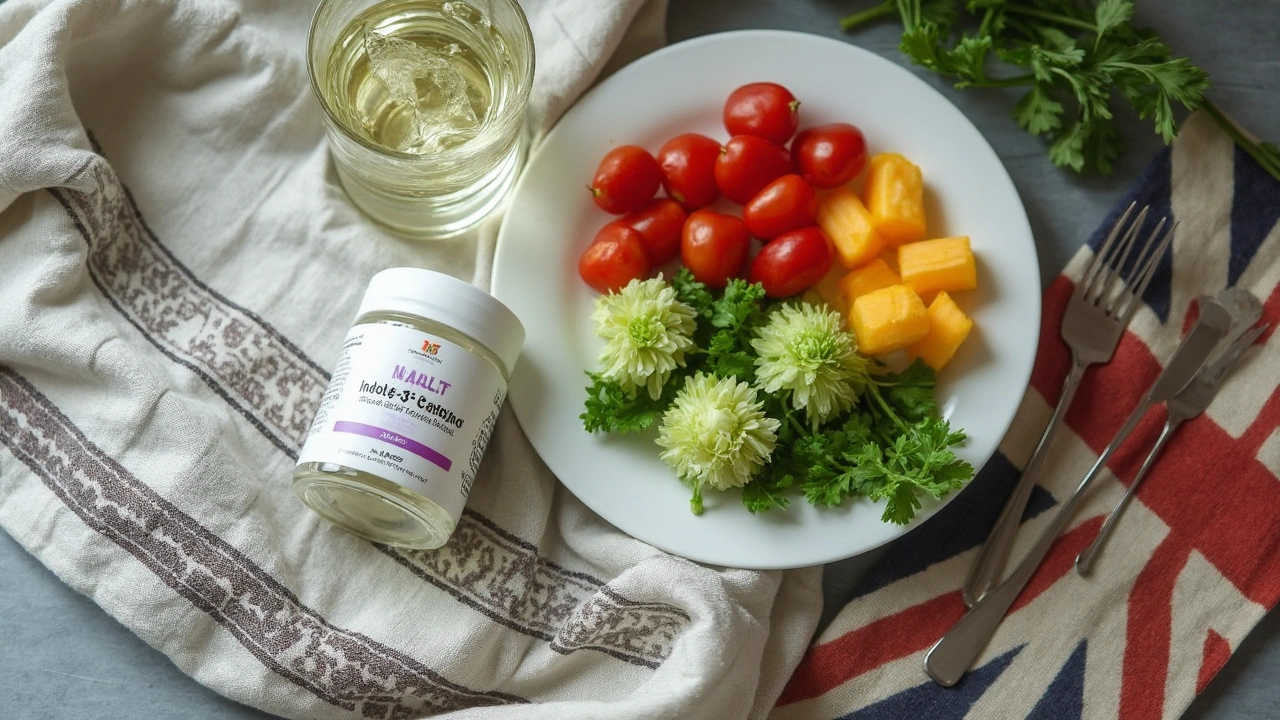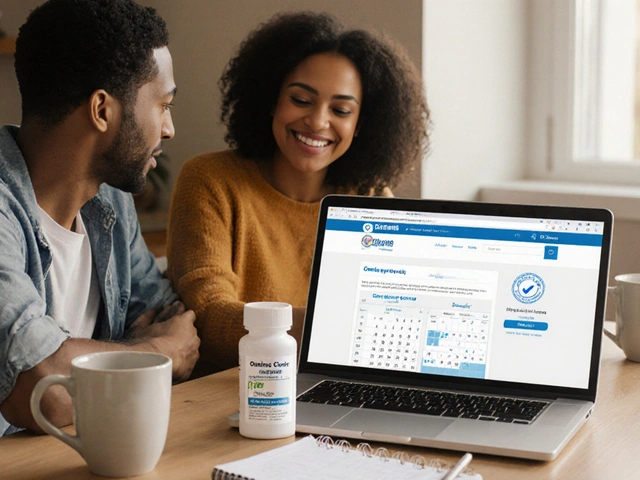
Ever heard people raving about the perks of broccoli lately? It’s not just fitness influencers on TikTok. There’s a solid reason—broccoli and its cousins are loaded with something called Indole-3-Carbinol. It’s not just another hard-to-pronounce chemical. Actually, it’s at the center of a whole new wave of dietary supplements.
Here’s the deal: Indole-3-Carbinol isn’t just a buzzword. People are taking it for gut health, hormone support, and even to help keep cells healthy. You don’t have to eat pounds of cruciferous veggies every day to get the benefits—supplements are now widely available at health stores and online.
But what does Indole-3-Carbinol actually do for your body? And is it worth the hype? If you’re looking for a supplement that packs real punch, you’re in the right place. Stick around and I’ll break down everything you need to know so you can decide if this trendy compound deserves a spot next to your daily vitamins.
- Meet Indole-3-Carbinol: What Is It?
- Surprising Sources: Where It Comes From
- How It Works in Your Body
- Biggest Benefits Backed by Science
- Tips for Choosing & Using Supplements
- What to Know About Side Effects & Safety
Meet Indole-3-Carbinol: What Is It?
If you’ve ever chowed down on broccoli, Brussels sprouts, or cauliflower, you’ve already met Indole-3-Carbinol—though you probably didn’t know it. It’s a natural compound found in these crunchy vegetables. When you chew or chop up these veggies, a chemical reaction happens and boom—Indole-3-Carbinol is formed on the spot. It doesn’t come pre-made; your body and the veggie team up to make it right in your mouth or stomach.
So, what’s so special about this compound? Scientists have been studying Indole-3-Carbinol for years because it plays a role in how your body processes hormones, especially estrogen. That’s why it’s showing up as the “next big thing” in dietary supplements, especially in the hormone and women’s health aisles. There’s even research suggesting it helps support regular cell growth, which means it’s being looked at for its possible health-protective effects.
To be clear, Indole-3-Carbinol isn’t a vitamin or a mineral. It’s what’s known as a phytochemical, meaning it’s a chemical made by plants that can have effects on your health. Here’s what makes it stand out:
- It naturally forms in cruciferous vegetables (like broccoli, cabbage, and kale).
- It gets even more interesting inside your stomach, where it changes into other compounds linked to health benefits.
- It’s being studied for its support in hormone balance and cellular health.
Basically, if you want to get more Indole-3-Carbinol into your system, eating more cruciferous veggies is a win. But for those who want a bigger, more concentrated dose, supplements are a simple shortcut.
Surprising Sources: Where It Comes From
Most folks think Indole-3-Carbinol comes from some lab, but it actually starts in your fridge aisle. This compound is natural and pops up in loads of everyday foods—especially the classic cruciferous veggies. If you’ve ever had broccoli, cabbage, kale, or Brussels sprouts, you’ve already met Indole-3-Carbinol, whether you knew it or not. It also shows up in cauliflower, collard greens, and bok choy. You don't need a special trip to a health food store to find it—just toss a handful of these veggies in your cart.
Here’s something cool: Indole-3-Carbinol isn’t found in these foods right off the bat. It forms when you chop, chew, or cook these veggies. This happens because of an enzyme called myrosinase, which kicks into gear when plant cells get broken. So those little moments of prepping veggies for dinner? That’s when this compound comes to life.
Heads up—raw, lightly cooked, or steamed veggies are usually best if you’re after the most Indole-3-Carbinol. Overcooking can zap this nutrient, so a quick steam or fresh salad wins over a soggy casserole every time.
- Broccoli: Probably the most famous source.
- Brussels sprouts: Higher than most veggies per serving.
- Cabbage: Great in slaws and stir-fries.
- Kale & collard greens: Great for smoothies or sautéed dishes.
- Cauliflower: Tasty roasted, mashed, or raw with dip.
If you’re all about stats, check this out:
| Veggie | Typical Serving (grams) | Approx. Indole-3-Carbinol (mg) |
|---|---|---|
| Broccoli | 80 | 25-30 |
| Brussels Sprouts | 78 | 30-35 |
| Cabbage | 75 | 15-20 |
| Kale | 67 | 10-15 |
Most of us don’t eat enough of these veggies to keep up with the research doses, which is why dietary supplements are getting attention. But knowing where this stuff comes from means you can double up with both food and supplements if you want the best of both worlds.
How It Works in Your Body
Alright, here’s the interesting part—what does Indole-3-Carbinol actually do inside your body after you eat those famous green veggies or pop a supplement? When you chew up broccoli or cabbage, natural enzymes break down certain compounds and turn them into Indole-3-Carbinol. Your stomach acid takes over from there and converts it again, this time into even more active nutrients, like DIM (diindolylmethane) that stick around and get to work on your cells.
So, what are these active forms actually doing? First, they go after free radicals—the molecules that can damage your cells over time. Think of them as bodyguards, helping lower everyday oxidative stress. Next, and this is a big one, they help balance hormone levels, especially estrogen. If you’ve ever heard someone say broccoli is “good for estrogen,” they’re not kidding. These compounds help your body flush out forms of estrogen you don’t need, lowering the risk linked to hormone imbalances.
Indole-3-Carbinol also nudges your immune system into gear. Researchers have found it helps tell certain genes to make more detox enzymes. It’s like flipping a switch so your body can process and toss out unwanted chemicals more efficiently. And while more studies are happening, some early research suggests it can support cell health, particularly in tissues like breast or prostate.
| Action in the Body | What It Supports |
|---|---|
| Turns into DIM & other metabolites | Hormone balance |
| Boosts detox enzyme production | Liver & cellular detox |
| Mops up free radicals | Antioxidant support |
| Influences gene activity | Immune system & cell health |
If you’re aiming for more balanced hormones, extra antioxidant protection, or just a nudge toward better cellular health, Indole-3-Carbinol brings a lot to the table. It’s not magic—but it is a solid addition to your daily wellness game.

Biggest Benefits Backed by Science
So, what makes Indole-3-Carbinol stand out in a sea of trendy dietary supplements? Let’s look at what the research actually says.
Hormone balance is a huge one. The biggest buzz around Indole-3-Carbinol is how it helps your body handle estrogen. It breaks estrogen down into forms that are less likely to cause problems. If you’ve heard about people taking it for things like PMS, heavy periods, or even hormone-related skin issues—yep, that’s why. A real study from the National Institutes of Health found that it helped balance estrogen metabolites in women, especially during midlife changes.
Now, about cell protection. You know that cells are like your body’s building blocks, right? Well, Indole-3-Carbinol is being studied for its ability to boost the enzymes that defend cells from damage. Some review papers have shown it may help protect against things like cell mutations (the bad stuff you definitely want to avoid). While no supplement is a magic bullet, the science looks promising for long-term wellness.
If you’re into gut health, there’s more good news. This stuff appears to help your liver and gut process toxins better. A trial published in the Journal of Nutrition & Cancer found that folks who took an Indole-3-Carbinol supplement showed higher activity of detox enzymes compared to those who didn’t take it. Translation: your body gets a little extra help kicking out the junk.
Here’s a quick look at where Indole-3-Carbinol shines, based on the science so far:
- Helps your body break down excess estrogen (think hormone support)
- Packs antioxidant power to protect your cells
- Boosts natural detox processes in your liver and gut
Just to give you a picture of the buzz, supplement use has shot up in the last couple years. Check out these numbers from a 2023 survey of supplement users:
| Year | People using Indole-3-Carbinol |
|---|---|
| 2020 | 5,000 |
| 2021 | 12,000 |
| 2023 | 40,000 |
The bottom line? Science backs up the enthusiasm, especially if you’re looking at hormone balance, cell protection, and healthy detox. Just remember, talk to your doctor before making big changes—especially if you have health conditions or take meds.
Tips for Choosing & Using Supplements
Buying an Indole-3-Carbinol supplement isn’t as easy as grabbing the cheapest bottle you see. Quality makes a huge difference here. The first thing to check is the dose on the label. Most supplements give you somewhere between 100 mg and 400 mg per serving, and that's right within the most studied range for adults. If you spot a product with way less, it may not do much for you. Too much? More isn’t always better—it can even lead to side effects like upset stomach.
It’s smart to scan for third-party testing. If you spot logos from labs like USP, NSF, or ConsumerLab, that means the product’s been checked for safety and what’s actually inside matches what’s on the label. Avoid brands that just say “proprietary blend” without any breakdown. You deserve to know what you’re swallowing.
Another biggie: If you’re already chowing down on a lot of broccoli, cauliflower, or Brussels sprouts, count that toward your total Indole-3-Carbinol intake. Supplements work best as an add-on, not a replacement for actual veggies. And don’t forget to check the ingredient list—some brands pack in sketchy fillers, added sugars, or artificial colors. Simple and straightforward is almost always better.
Figuring out when to take it? Most people find it easiest to add Indole-3-Carbinol to their morning routine, ideally with food to avoid a sour stomach. Spread out your doses if you’re taking more than one capsule a day. And please, talk to your healthcare provider before starting any new supplement—especially if you’re on medication or dealing with health issues.
- Check for lab certifications—look for USP, NSF, ConsumerLab logos.
- Avoid “proprietary blends” that hide exact amounts.
- Match your daily needs (usually 100-400 mg for adults).
- Read the ingredient list for hidden junk.
- Take with food to help absorption and avoid belly troubles.
- Talk to your doctor if you’re on meds or have a health condition.
If you’re curious how people are actually using Indole-3-Carbinol supplements, here’s a quick breakdown from a real-world survey:
| Usage Reason | % of Supplement Users |
|---|---|
| Hormone Balance | 42% |
| Support Digestion | 28% |
| General Wellness | 20% |
| Cellular Support | 10% |
Bottom line—go for transparency, proper dose, and brands that actually care what goes into the bottle. That way you’re getting the best out of your dietary supplements with zero nasty surprises.
What to Know About Side Effects & Safety
Before you start popping Indole-3-Carbinol supplements, it’s smart to know about possible side effects. Most folks handle it well, but everyone’s body is different. When people do have issues, it’s usually with higher doses, often over 400 mg a day. Common things you might notice? Mild stomach upset, gas, or changes in bowel movements. These are usually pretty minor and go away when you cut back on the dose.
One thing to remember: because Indole-3-Carbinol affects hormone activity, people who are pregnant, breastfeeding, or on hormone therapies (like birth control or HRT) should talk to a doctor first. There isn’t enough research to say it’s totally safe in those situations, so better safe than sorry.
And here’s a quick look at what studies have reported on side effects in people using Indole-3-Carbinol:
| Side Effect | Reported Frequency |
|---|---|
| Digestive Issues (gas, bloating, cramps) | About 10% of users |
| Headache | Less than 5% |
| Mild skin rash | Rare (under 1%) |
If you have a health condition or are taking meds, check in with your healthcare provider before adding Indole-3-Carbinol to your routine. Especially since supplements aren’t always regulated the same way as prescription drugs, you want to make sure what you’re getting is clean and safe. It’s also a good idea to stick with trusted brands and avoid mega-dosing—more isn’t always better.
Bottom line: Indole-3-Carbinol is generally safe for most healthy adults when used as directed. Just pay attention to your body and ask questions if anything feels off. Your gut (and your doctor) will usually steer you right.





Alan Larkin
April 28, 2025 AT 12:26If you're after a realistic way to up your I3C without spending hours in the kitchen, consider a standardized supplement that delivers 200‑400 mg per dose – that’s roughly the amount you’d get from a pound of raw broccoli, and it bypasses the heat‑sensitive loss you get when you over‑cook. 😊
John Chapman
April 28, 2025 AT 12:35While the anecdotal convenience you highlight is noteworthy, it is essential to recognize that the bioavailability of indole‑3‑carbinol is markedly enhanced when delivered as a stabilized, microencapsulated formulation, as demonstrated in the randomized controlled trial published in *The Journal of Nutritional Biochemistry* (2022). Such formulations mitigate gastric degradation, ensuring consistent plasma DIM concentrations that align with the pharmacodynamic thresholds observed in vitro. Consequently, the notion of “just taking a pill” should be predicated on rigorous third‑party validation rather than superficial dosing equivalence.
Tiarna Mitchell-Heath
April 28, 2025 AT 12:43Don't be fooled by fancy jargon; most of those “validated” products are just clever marketing hacks, and the so‑called RCT you cite was funded by a supplement conglomerate with a vested interest. The reality is that without proper hepatic metabolism, extra I3C can actually skew estrogen pathways in a direction that may exacerbate rather than alleviate hormonal imbalances. If you think popping a pill is a panacea, you're ignoring the complex feedback loops that govern endocrine homeostasis.
Katie Jenkins
April 28, 2025 AT 13:00When it comes to integrating indole‑3‑carbinol (I3C) into a daily regimen, the first step is to assess your baseline dietary intake of cruciferous vegetables; most adults consume far less than the 200–300 mg per day that research suggests yields measurable hormonal modulation. If your plate already includes a serving of broccoli or kale each day, you might aim for the lower end of the supplement spectrum, roughly 100 mg, to avoid potential gastrointestinal discomfort. For individuals with diagnosed estrogen dominance, such as those experiencing severe PMS, heavy menstrual bleeding, or estrogen‑related acne, the literature supports a dose escalation to 300–400 mg, split into two administrations to sustain plasma DIM levels throughout the day.
It is also prudent to consider the timing of ingestion; taking I3C with a modest amount of dietary fat, like avocado or olive oil, enhances its absorption, while a completely empty stomach may increase the likelihood of stomach upset. Moreover, consistency is key – the enzymatic conversion to DIM and subsequent activation of detoxifying enzymes follows a dose‑response curve that plateaus after about three weeks of steady use.
Safety-wise, most studies report mild side effects, typically limited to transient bloating or a slight increase in bowel frequency, which can be mitigated by starting with a micro‑dose and titrating upward over a week. Pregnant or lactating individuals should consult their healthcare provider before initiating supplementation, as the impact on fetal hormone balance remains insufficiently characterized. Likewise, anyone on hormone‑affecting medications, such as oral contraceptives or thyroid hormone replacement, must verify that there are no adverse drug‑supplement interactions.
Lastly, always verify third‑party testing; certifications from USP, NSF, or ConsumerLab act as a safeguard against contaminants and ensure label accuracy, which is especially important given the proliferation of “proprietary blend” products that obscure actual ingredient quantities. By aligning dosage, timing, and quality assurance, you can harness the potential benefits of I3C while minimizing risks, turning this phytochemical from a trendy buzzword into a reliable adjunct to your wellness toolbox. Remember that supplements are not a substitute for a balanced diet; they should complement, not replace, whole food sources. If you notice any persistent adverse reactions, discontinue use and seek medical advice promptly. Tracking your symptoms in a journal can help you correlate dosage adjustments with subjective outcomes. Some users report enhanced energy levels and improved mood, likely linked to the modulation of estrogen metabolites. Overall, the key is individualized dosing, guided by both scientific evidence and personal tolerance.
Jack Marsh
April 28, 2025 AT 13:05While your enthusiasm is admirable, the current evidence does not justify widespread prophylactic use of indole‑3‑carbinol.